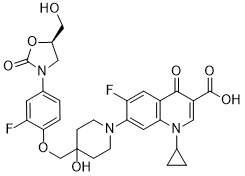Cadazolid (ACT-179811)
This product is for research use only, not for human use. We do not sell to patients.

For small sizes, please check our retail website as below: www.invivochem.com
| Size | Price | Stock |
|---|---|---|
| 250mg | $1250 | Check With Us |
| 500mg | $1850 | Check With Us |
| 1g | $2775 | Check With Us |
Cat #: V17419 CAS #: 1025097-10-2 Purity ≥ 98%
Description: Cadazolid, also known ACT-179811, is a novel fluoroquinolone-oxazolidinone antibiotic and a protein synthesis inhibitor.
Top Publications Citing Invivochem Products
Publications Citing InvivoChem Products
Product Promise

- Physicochemical and Storage Information
- Protocol
- Related Biological Data
- Stock Solution Preparation
- Quality Control Documentation
| Molecular Weight (MW) | 585.55 |
|---|---|
| Molecular Formula | C29H29F2N3O8 |
| CAS No. | 1025097-10-2 |
| SMILES Code | Cadazolid; ACT-179811; ACT 179811; ACT179811; |
| Synonyms | O=C(C1=CN(C2CC2)C3=C(C=C(F)C(N4CCC(O)(COC5=CC=C(N6C(O[C@@H](CO)C6)=O)C=C5F)CC4)=C3)C1=O)O |
| Protocol | In Vitro | Cadazolid is a new antibiotic in development for the treatment of Clostridium difficile-associated diarrhea. |
|---|---|---|
| In Vivo | Cadazolid is well tolerated up to 3000 mg given twice daily for 10 days. The most common adverse event is headache, with no observed relationship between dose or treatment duration and adverse events. Plasma concentrations of cadazolid are low. No plasma concentrations >3.3 ng/mL are observed after single doses or >6.9 ng/mL after 10 days of multiple doses. Food increased the mean Cmax from 0.73 to 1.87 ng/mL and mean AUC0–t from 3.13 to 15.69 ng·h/mL after a single 300 mg dose. The increase in systemic exposure to cadazolid across doses is less than dose-proportional. The mean cumulative faecal recovery is 81.0%–93.5%. Urinary recovery of unchanged compound is less than 0.015%. |
These protocols are for reference only. InvivoChem does not
independently validate these methods.
| Solvent volume to be added | Mass (the weight of a compound) | |||
|---|---|---|---|---|
| Mother liquor concentration | 1mg | 5mg | 10mg | 20mg |
| 1mM | 1.7078 mL | 8.5390 mL | 17.0780 mL | 34.1559 mL |
| 5mM | 0.3416 mL | 1.7078 mL | 3.4156 mL | 6.8312 mL |
| 10mM | 0.1708 mL | 0.8539 mL | 1.7078 mL | 3.4156 mL |
| 20mM | 0.0854 mL | 0.4269 mL | 0.8539 mL | 1.7078 mL |
The molarity calculator equation
Mass(g) = Concentration(mol/L) × Volume(L) × Molecular Weight(g/mol)
Mass
=
Concentration
×
Volume
×
Molecular Weight*
The dilution calculator equation
Concentration(start)
×
Volume(start)
=
Concentration(final)
×
Volume(final)
This equation is commonly abbreviated as: C1 V1 = C2 V2
Concentration(start)
C1
×
Volume(start)
V1
=
Concentration(final)
C2
×
Volume(final)
V2
Step One: Enter information below
Dosage mg/kg
Average weight of animals g
Dosing volume per animal µL
Number of animals
Step Two: Enter the in vivo formulation
%DMSO
+
%
+
%Tween 80
+
%ddH2O
Calculation Results:
Working concentration:
mg/ml;
Method for preparing DMSO master liquid:
mg
drug pre-dissolved in
µL
DMSO(Master liquid concentration
mg/mL)
,Please contact us first if the concentration exceeds the DMSO solubility of the batch of drug.
Method for preparing in vivo formulation:
Take
µL
DMSO master liquid, next add
µL
PEG300, mix and clarify, next add
µL
Tween 80,mix and clarify, next add
µL
ddH2O,mix and clarify.
Note:
- (1) Please be sure that the solution is clear before the addition of next solvent. Dissolution methods like vortex, ultrasound or warming and heat may be used to aid dissolving.
- (2) Be sure to add the solvent(s) in order.




































